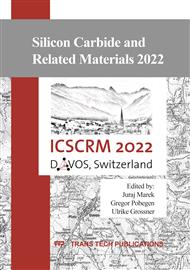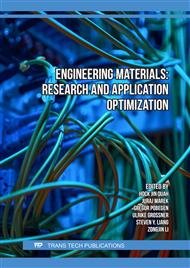[1]
P. Friedrichs, SiC Devices for Mainstream Adoption, 2018 IEEE IEDM, 2018: 19.1.1-19.1.4.
DOI: 10.1109/iedm.2018.8614625
Google Scholar
[2]
Imaizumi, Masayuki, and Naruhisa Miura. Characteristics of 600, 1200, and 3300 V planar SiC-MOSFETs for energy conversion applications. IEEE Trans Electron Devices, 62.2 (2014) 390-395.
DOI: 10.1109/ted.2014.2358581
Google Scholar
[3]
X. She, A.Q. Huang, O. Lucia, et al. Review of silicon carbide power devices and their applications. IEEE Trans. Ind. Electron. 64.10 (2017) 8193-8205.
DOI: 10.1109/tie.2017.2652401
Google Scholar
[4]
T. McDonald, M. Soldano, et al. Power MOSFET avalanche design guidelines. International rectifier Application Note, AN-1005 (2000).
Google Scholar
[5]
J. Ng, J. Sin, et al. UIS analysis and characterization of the inverted L-shaped source trench power MOSFET." IEEE Trans Electron Devices 58.11 (2011) 3984-3990.
DOI: 10.1109/ted.2011.2164081
Google Scholar
[6]
S.Y. Liu, et al. Repetitive unclamped-inductive-switching-induced electrical parameters degradations and simulation optimizations for 4H-SiC MOSFETs. IEEE Trans Electron Devices. 63.11 (2016) 4331-4338.
DOI: 10.1109/ted.2016.2604253
Google Scholar
[7]
N. Ren, et al. Investigation on single pulse avalanche failure of SiC MOSFET and Si IGBT. Solid State Electron. 152 (2019) 33-40.
DOI: 10.1016/j.sse.2018.11.010
Google Scholar
[8]
A. Castellazzi, et al. Transient out-of-SOA robustness of SiC power MOSFETs. 2017 IEEE International Reliability Physics Symposium (IRPS). IEEE, 2017.
DOI: 10.1109/irps.2017.7936255
Google Scholar
[9]
I.H. Ji, et al. Highly rugged 1200 v 80 mQ 4-H SiC power MOSFET. 2017 29th International Symposium on Power Semiconductor Devices and IC's (ISPSD). IEEE, 2017.
DOI: 10.23919/ispsd.2017.7988995
Google Scholar
[10]
J. An, and S. Hu. Experimental and theoretical demonstration of temperature limitation for 4H-SiC MOSFET during unclamped inductive switching. IEEE Journal of Emerging and Selected Topics in Power Electronics 8.1 (2019) 206-214.
DOI: 10.1109/jestpe.2019.2944167
Google Scholar
[11]
S. Soneda, et al. Analysis of a drain-voltage oscillation of MOSFET under high dV/dt UIS condition. 2012 24th International Symposium on Power Semiconductor Devices and ICs. IEEE, 2012.
DOI: 10.1109/ispsd.2012.6229046
Google Scholar
[12]
K. Han and B.J. Baliga. Comprehensive physics of third quadrant characteristics for accumulation-and inversion-channel 1.2-kV 4H-SiC MOSFETs. IEEE Trans Electron Devices. 66.9 (2019) 3916-3921.
DOI: 10.1109/ted.2019.2929733
Google Scholar
[13]
R. Zhang, X. Lin, et al. Third quadrant conduction loss of 1.2–10 kV SiC MOSFETs: Impact of gate bias control. IEEE Trans. Power Electron. 36.2 (2020) 2033-2043.
DOI: 10.1109/tpel.2020.3006075
Google Scholar



